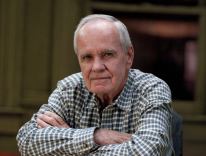Christ the Lord
Out of Egypt
Anne Rice
Alfred A. Knopf, $25.95, 322 pp.
In his classic work Mimesis, Erich Auerbach observed that the narrative of the Bible is all foreground; it is left to the human imagination to fill in the background. This is certainly true of the gospel portrait of Jesus.
For two thousand years people have imagined how Jesus might have looked, what his childhood was like, whether he ever laughed, what he did for work, and how he prayed in those periods when, the evangelists tell us, he went off by himself to out-of-the-way places. This impulse to “fill in” produced a spate of noncanonical gospels, and gave birth to a whole tradition of poetry, fiction, and drama as well as a rich treasure of visual arts.
The modern imagination has not resisted the temptation to “fill in,” as the recent success of Mel Gibson’s (truly awful) The Passion of the Christ attests. Fictional works about Jesus are usually not very good. Think of Martin Scorsese’s The Last Temptation of Christ, where Jesus sounds suspiciously like Zorba the Greek, or the cloyingly sentimental Godspell or Jesus Christ Superstar. A number of novelists have more artfully recast Jesus as a social critic. In Bernard Malamud’s The Fixer, the Jesus figure is a persecuted Jew. Other writers have sought to portray the “hidden Christ” of the poor, like the Christ-like whiskey priest of Graham Greene’s The Power and the Glory.
Anne Rice’s Christ the Lord imagines the life of Jesus from the Holy Family’s escape from the murderous Herod to their return home to Nazareth. Her novel ends before Jesus’ famous encounter with the learned ones in the Temple at the age of twelve. The story of Jesus’ birth is also recounted, although indirectly, as the young Jesus learns about it from others. This is the story of the child Jesus and, I must admit, I was prepared to dislike it (show me a novel about Jesus and I reach for my Bible). To my surprise, Anne Rice has written a fine book.
I liked it for two reasons. One, Rice is a first-rate writer. There are no purple patches in this narrative, and no attempts to sermonize. There is a story to tell, and since we know the story on which it is based, Rice adroitly forces us to think about how she is going to weave in the gospel stories without sounding contrived or forced. Two, Rice’s book has the ring of verisimilitude. She has obviously done extensive research. For example, she places Jesus’ family in Alexandria, which allows her to imagine that Jesus had studied with the great Philo. When the family settles in Nazareth, Rice has Joseph plying his trade in nearby Sepphoris, an ancient town that we know much about thanks to extensive excavation. Rice also offers a plausible explanation about how the “brothers and sisters” of Jesus are related to him. She incorporates details from noncanonical sources. Borrowing from the apocryphal Gospel of James, Rice suggests that Mary lived in the Temple as a child, sewing veils for the Holy of Holies. Above all, Rice presents Jesus as a born-and-bred Jew: his family participate in the life of the synagogue, and they make periodic pilgrimages to the Temple.
In interviews, Rice has suggested that some contemporary critics dislike Jesus, and have tried to simplify him for their own ideological purposes. Rice does no such thing. She is a believing Catholic and writes from that perspective. No literal-minded fundamentalist, she presents a subtle account of how Jesus becomes conscious of his messianic destiny and divine origins. She does not in any way portray him as a kind of spiritual schizophrenic. Rather, one could read this well-wrought novel as a long meditation on the tantalizing observation of Luke: “The child grew and became strong, filled with wisdom, and the favor of the Lord was upon him.”
Illuminating the Word
The Making of the St. John’s Bible
Christopher Calderhead
Liturgical Press, $64.95, 216 pp.
More than a decade ago, the monastic community of St. John’s Abbey in Collegeville, Minnesota, decided to publish an illuminated and hand-written Bible, much like the great Bibles of the past. They asked the noted British calligrapher Donald Jackson (scribe to Queen Elizabeth II) to oversee the project. The finished work will consist of seven volumes: “Pentateuch,” “Historical Books,” “Wisdom Literature,” “Psalms,” “Prophets,” “Gospels and Acts,” “Letters and Revelation.” The project is the collaborative work of the monks of St. John’s and a community of calligraphers under Jackson’s supervision. The first fruits of the project have now been published: facsimiles of the “Gospels and Acts” volume are available from Liturgical Press.
Christopher Calderhead’s Illuminating the Word recounts how the St. John’s Bible was created, and features, in beautiful illustrations, some of the finished work. He explains how the inks and quill pens were made (from the feathers of swans, geese, and turkeys); the difficulty of acquiring vellum, which is used as parchment; how the calligraphers did their work; and the tedium of composing the illustrations. The result is both an exploration of an art form of the past and a demonstration of how mundane material becomes, in the hands of the very skilled, a work of art.
But why, the mildly philistine might ask, go to such trouble when the Gideons hand out free Bibles all over America? The first and obvious reason is that the St. John’s Bible is a thing of beauty and that it may prompt people to look at the Bible not as a cheap commodity, but as something of enduring worth. Furthermore, as Abbot John Klassen of Collegeville says, it is an attempt to connect the Catholic imagination to the Word, which is one of the hallmarks of the Catholic tradition. Finally, it links the monks of today with an ancient monastic tradition: copying biblical texts as a form of lectio divina.
Apostolicity Then and Now
John J. Burkhard
Liturgical/Michael Glazier, $27.95, 250 pp.
Apostolicity is one of the things that we affirm in our creed: We state that our church is one, holy, catholic, and apostolic. That nexus between the apostolic witness and the present reality of the church is of profound theological significance. The church today is in communion with and gives witness to the faith preached by the apostles. We understand the bishops to be the successors of those apostles. Apostolicity should not be understood in some crude genealogical sense, as if we could trace back our local bishop to this or that apostle. Rather, the bishops today receive their authority by being the reflection of and heirs to the apostolic churches founded in antiquity.
In his excellent study, Apostolicity Then and Now, John Burkhard recounts the origins of the notion of apostolicity, how the concept evolved in history, what contemporary theologians and ecumenical experts have made of it, and what apostolicity means in our postmodern world. He argues convincingly that a clear grasp of apostolicity is crucial in order to discuss serious church issues such as the exercise of authority and the meaning of tradition. According to Burkhard, apostolicity must not be equated only with apostolic succession. The notion must also be understood as fidelity to the apostolic tradition as it has manifested itself through history.
This book is a summary of two decades of research. Burkhard knows the literature, writes well, and is sympathetic toward theologians who represent other Christian churches. I read this book while teaching a graduate seminar on John Henry Newman, someone with a great interest in apostolicity. Burkhard puts Newman in conversation with such writers as Congar and the present pope. This book would have benefited from a bibliography and an index, but it is still one of the better books on ecclesiology I have read in the past few years.
A Short History of Thomism
Romanus Cessario, OP
Catholic University of American Press, $19.95, 106 pp.
The operative word in the title of Romanus Cessario’s book is Short. He provides a breathless overview of the influence of Thomas’s work throughout history. Cessario’s definition of what constitutes the Thomist school is fairly restrictive; he cites Alasdair MacIntyre’s judgment that transcendental Thomism (see Bernard Lonergan or Karl Rahner) is an “unfortunate hybrid,” and includes in his own study only those who work exclusively in the Thomist tradition. He surveys the standard periods in which Thomas’s work was most popular-from the great theologian’s own time, when he had to defend his work, to the flourishing of Neo-Thomism in the latter half of the nineteenth century.
Cessario’s book reminds us that there are many currents that flow out of the works of Thomas and, for that, we may thank the author. A Short History of Thomism gives little sense, however, of the important work being done on Aquinas today. Cessario devotes roughly six pages to contemporary Thomism. In contrast, After Aquinas: Versions of Thomism (Blackwell Publishers) by Fergus Kerr sorts out the various modern takes on Thomas’s thinking. Nor does Cessario provide any sense of how fecund the conversation between Thomas and, say, Reformed theology or the Greek patristic tradition has been. Cessario gives us a fair account of the Thomistic commentary tradition, but when it comes to the Thomistic revival in our own day, he serves up thin gruel.
History, Theology & Faith
Dissolving the Modern Problematic
Terrence Tilley
Orbis, $30, 211 pp.
The three religions of Abraham—Judaism, Christianity, and Islam—all share the common belief that God intervened in human events. None of these traditions claims its foundational story began “once upon a time,” but rather each begins with real people who lived in historically discernible eras. The problem occurs, of course, when one attempts to verify the historicity of religious claims.
“Christ has died, Christ has risen, Christ will come again” is asserted in the Christian liturgy, but did Jesus, in fact, rise? Questions like that have generated mountains of books, monographs, and doctoral theses. As Terrence Tilley notes in History, Theology & Faith, however, the grounds upon which such questions are discussed remain maddeningly elusive. Even basic assumptions accepted by the majority of those investigating the historical Jesus—the priority of Mark, the existence of a lost written “Q” source—are debatable.
The quest for the historical Jesus is only one problem that Tilley discusses in this well-written and sophisticated work. After all, even such “hot button” topics as who may be ordained to the ministerial priesthood—to name an obvious one—must appeal to history. Likewise, as John Noonan has shown in his most recent work, moral questions are also shaped by historical circumstance. Tilley explores classic works on the hermeneutical problems of history from Ernst Troeltsch and Max Weber and puts them in conversation with more recent theologians like George Lindbeck and David Tracy. Tilley rejects the notion that history and theology cannot coexist. Writing as a Catholic theologian he has good reason to do so. Tilley is well aware of the development of doctrine and knows that ressourcement is a precious tool for church renewal.
History does not “authorize” a religious tradition, according to Tilley, but history does make judgments “on which claims best articulate the principles of a tradition.” For the theologian, the uses of history are of necessity both critical and, simultaneously, subtle. What Tilley attempts to do is navigate around any crude reductionistic historicism in order to do justice to the Christian tradition—the regula fidei—and to the claims of history. This book is not for the casual reader, but for anyone seriously interested in the theological project, it is an illuminating addition to contemporary discussions.
Constructive Theology
A Contemporary Approach to Classical Themes
Edited by Serene Jones and Paul Lakeland
Fortress, $30, 309 pp.
For the past generation, a group of American theologians has met and published works on “constructive theology.” This latest volume is the work of fifty professors from a wide range of public and denominational schools. Their goal is to sketch the terrain of “images, stories, concepts, practices, and feelings that sum up ‘what we believe in.’” They take seriously St. Anselm’s classic definition of theology: “faith seeking understanding.”
The contributors seek to explore certain classic doctrinal topics—God, human anthropology, sin and evil, Christology, ecclesiology, and the Spirit. Each chapter provides limited historical background on these topics and also contemporary reflections. In addition, there are sidebars on “special questions.” For example, in the chapter on the Spirit, there is an excursus on topics as different as early Montanism and “Womanism and Native American Religion.” Evidently, the writers hope that this can be used as a textbook for beginning theology students (the book comes with a CD-ROM).
Because all the writers are academics, who are as loyal to the standards of the academy as to the Christian tradition, the tone of the volume is fairly predictable. It is liberal, politically inclusive (be prepared for fine discriminations among feminist, postfeminist, mujerista, and “womanist” thought), heavy on current “theory,” and pious in its use of the current patois of the academy. (Jesus is described in one place as an example of “transgendered masculinity.”) In short, it is exactly the kind of book one would expect from fifty professors of quite different Christian denominations.
Here is the problem with a book of this sort: it has no coherent starting point. When reading an individual theologian, one understands where that theologian is coming from: Karl Barth is a classical Protestant theologian who wrote against the grain of nineteenth-century liberal theology. He worked out of a tradition. The contributors to Constructive Theology do not represent a tradition; they represent many traditions within the broad stream of Christianity.
Anyone who seeks to understand his or her faith by reading this book will likely be bewildered. This is not to say that there are not good patches here and there, but it is not the kind of book to use if you are working with students seeking to understand theology from a coherent starting point, such as a class of Roman Catholic MDiv students. Some may consider this too parochial a critique, but think of the alternative: an amorphous ecumenism that dips into and tastes of all kinds of traditions within Christianity (except for Orthodoxy, which, as usual, rarely gets even a nod). Lastly, in this book, everything is seen through the lens of the somewhat evanescent current interests of academics.
Some of the contributors are fine theologians who do very important work. Their skills, though, are lost amid the sprawling text and academic political chatter. This book is too ambitious in its aim and too limited in its performance. Were one to put this volume in the hands of a beginning theology student, he or she would not get any sense of the magisterial sweep of the Christian theological tradition. It has been said that the King James Bible is the only work ever done by a committee that is a classic. That judgment still stands.
Please email comments to [email protected] and join the conversation on our Facebook page.
Share
Previous Story
Devils, Dust & God
Next Story
Letters


